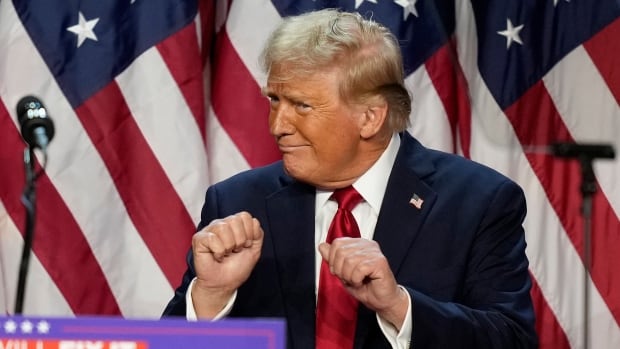here we go again.
Canadian industry is bracing for disruption, discord and, above all, tariffs. Donald Trump’s landslide victory in this week’s presidential election sets the stage for a series of obstacles to trade between Canada and its largest trading partner.
But for those who spent much of President Trump’s first term defending Canada’s interests in the trade war, there is an eerie sense of deja vu.
“We have history and experience to draw on,” said Catherine Cobden, president and CEO of the Canadian Steel Producers Association.
Back in 2018, President Trump imposed a 25% tariff on steel imports.
Ultimately, Canadian negotiators persuaded the Republican president to grant Canada an exemption. Cobden said Canada is one of the few countries negotiating a cancellation.
“The reason we decided there shouldn’t be tariffs between Canada and the United States is because we saw that tariffs hurt both sides of the border,” she told CBC News.
Some of Canada’s largest industries are already strategizing how to respond to U.S. President-elect Donald Trump’s threat to impose steep tariffs on all goods imported into the United States. Economists say Canada’s GDP could be cut by up to 5 per cent.
Since then, Canada has imposed steep tariffs on China and introduced new rules to clarify where steel comes from. Cobden said both measures should help make it clear that Canada and the United States have more in common than the president-elect thinks.
“I’m not going to say I’m hopeful because there’s a lot of uncertainty, but I feel like we have a chance to do the good job we’ve done so far… and stand up and stand together with the United States.” she said.
Canadian industry has weathered President Trump before.
This tactic sounds all too familiar to Flavio Volpe, president of the Canadian Auto Parts Industries Association, who was one of the front lines of trade disputes during the first Trump presidency. He said President Trump expects renegotiation of the North American Free Trade Agreement to take six to seven weeks. It took 13 months.
Mr. Volpe focused on emphasizing that half of the cars manufactured in Canada are made by American companies, and half of the parts used in the manufacturing process come from the United States.
“We were able to show them that their interests are better served with us than with any other partner they have,” he said this week.

Canada’s auto industry, steel companies, aluminum producers and dairy industry have weathered this storm before. But now, even industries that weathered the last Trump era without major disruption are concerned.
Grain farmers are being hit by high tariffs from China after Canada decided to impose its own tariffs on Chinese-made electric cars.
China is Canada’s second largest grain export market. The biggest one, of course, is the United States, where farmers are currently focused on President Trump’s possible 10% tariffs.
“Any distortion in trade with the U.S. will have a direct impact on the 65,000 grain farmers who make their living across the country,” said Kyle Larkin, executive director of the Canadian Grain Producers Association. ” he said.

Grain farmers export more than 8 million tonnes to the United States each year, valued at nearly C$9.5 billion.
“The relationship between Canada and the United States is not only important for grain farmers and agriculture, but also for the Canadian economy as a whole,” Larkin said.
Leveraging the threat of tariffs
In addition, a new NAFTA renegotiation, now called the Canada-United States-Mexico Agreement (CUSMA), is looming in 2026.
Despite the fears and concerns about these negotiations, trade on the continent has flourished since the agreement was renewed in 2019.
“As of last year, total exports between Canada, the U.S. and Mexico exceeded C$1.5 trillion, nearly 30% above 2019 levels,” said Mark Ercolao, an economist at TD Bank.

One of the core issues in President Trump’s trade policy is disagreement over whether the next U.S. president actually understands how tariffs work. President Trump has repeatedly insisted that they are paid by their countries of origin. In fact, customs duties are paid by consumers who purchase imported goods.
“I don’t think he understood who was paying the tariffs, but I also don’t think he cared,” Volpe said. “He knew that if he made that threat, we would make some concessions and come to the table. That was the important part.”
So the key, he said, is understanding how President Trump is leveraging the threat of tariffs.
The Grain Growers Association said the key was a “cautious and patient approach”.
Larkin said no one knows what will happen between now and Inauguration Day, and no one knows which industries will be targeted by the incoming administration.
However, he said he knows that a review of CUSMA will be done soon.
Jimmy Jean, chief economist at Desjardins, said U.S. President-elect Donald Trump’s plan to impose sweeping tariffs on imports could spark a trade dispute and disrupt Canada’s economy.
”[The] Free trade agreements really connect all of our trade and grain farmers’ livelihoods. So we need to be aware of that, we need to engage early and we need to engage often,” Larkin said.
In this regard, Mr. Volpe said that changes in the country’s political situation are also important. When Trump wanted to renegotiate NAFTA during his first term, Canada came to the table with a bipartisan approach that included former prime ministers and current opposition members, he said.
“I think our politics here are a little bit polarized. I hope we can play that part. That was a very, very important part,” Volpe said.
Industry leaders say there is a path forward for any challenge, and there is good reason to believe Canada can overcome whatever obstacles it faces.


